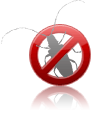Sap stain

- Latin : Ceratocystis polonica (Siemaszko) C. Moreau
- English: Sap stain
- French: Champignon de bleuissement
- Order/Class: Stilbellales
Description
Distribution
This species is not found in Canada
Micro-habitat(s)
Wood
Damage, symptoms and biology
When conifers are infected with a fungus, they often react by secreting some resin around the points of entry. Abundant secretions are released in response to attack by Ophiostoma polonicum; this response appears to be commensurate with the virulence of the fungus. The infected tissues fill up with resin, in order to impede the spread of the mycelium and the toxins that are released. However, C. polonica overcomes the natural defences of trees, even healthy ones, and rapidly invades the vessels in which sap circulates. Sap circulates through the phloem and the xylem (or sapwood); the phloem tissues transport the sap produced by the leaves, and the xylem transports the water taken up from the soil by the roots. The ability of the fungus to grow in the wet part of the wood, an oxygen-depleted environment, likely explains the rapid inroads it is able to make and the severity of the damage it causes in trees. The size of the lesions that appear under the bark depends on the virulence of the attack. Not only does the fungus destroy large portions of the sapwood, it also invades the cambium, that is, the living tissues that ensure the tree’s diameter growth. C. polonica is highly virulent and one of the only fungi in its genus that can cause a reduction in diameter growth just a few weeks after it infects a tree. The lesions cut off the tree’s supply of water and nutrients, causing the leaves to wilt and the tree to dry out. Trees die within about 15 weeks of mass inoculation with the fungus.
Comments
Ceratocystis polonica was isolated and identified for the first time in Poland, in 1939. This blue stain fungus, an ascomycete, is often associated with the European spruce bark beetle (Ips typographus L.), its primary vector. Of the many fungal species associated with this bark beetle, Ceratocystis polonica is the most widespread and it definitely poses the greatest threat. Other bark beetles may also vector C. polonica: Hylurgops palliatus; Ips amitinus; Ips duplicatus; Pityogenes chalcographus; Polygraphus poligraphus.
In Europe, this fungus causes significant mortality in Norway spruce, its preferred host. It shows a high level of pathogenicity against Norway spruce, regardless of the age and health of the infected tree.
The European spruce bark beetle is an aggressive species that spreads the disease quickly and is also associated with several other blue stain fungi. In order to complete its development and reproduction, this beetle species requires thick-barked stems. That is why it is only found on trees with a diameter greater than 25 cm. Since the species also requires freshly felled or windthrown trees, bark beetle attacks often occur after major storms that produce large areas of windthrow.
References
Christiansen, E.; Solheim, H. 1990. The bark beetle blue stain fungus Ophiostoma polonicum can kill various spruces and Douglas fir. Eur. J. For. Pathol. 20:436-446.
Christiansen, E.; Solheim, H. 1994. Pathogenicity of five species of Ophiostoma fungi to Douglas-fir. Meddelelser-fra-Skogforsk. 47: 12 pp.
Farr, D.F.; Rossman, A.Y. [N.D.]. Fungal Databases, Systematic Mycology and Microbiology Laboratory, ARS, USDA. http://nt.ars-grin.gov/fungaldatabases/. Consulté le 20 décembre 2011.
Global Biodiversity Information Facility. Chrysomyxa abietis (Wallr.) Unger 1840. http://data.gbif.org/species/14377170/. Consulté le 14 novembre 2008.
Harrington, T.C.; Pashenova, N.V.; McNew, D.L.; Steimel, J.; Konstantinov, M.Y. 2002. Species delimitation and host specialization of Ceratocystis laricicola and C. polonica to larch and spruce. Plant Dis. 86:418-422.
Jankowiak, R.; Kolarik, M. 2010. Diversity and pathogenicity of ophiostomatoid fungi associated with Tetropium species colonizing Picea abies in Poland. Folia Microbiol. 55:145-154.
Krokene, P.; Solheim, H. 1998. Pathogenicity of four blue-stain fungi associated with aggressive and nonaggressive bark beetles. Phytopathology 88:39-44.
Lieutier, F.; Day, K.R.; Battisti, A.; Grégoire, J.-C.; Evans, H.F. (Eds.). 2007. Bark and Wood Boring Insects in Living Trees in Europe, A Synthesis. Springer, Dordrecht, The Netherlands. pp. 19-38.
North American Plant Protection Organization. 2005. Phytosanitary Alert System. Ceratocystis species. Sap stain fungi of conifers of potential quarantine concern to North America. http://www.pestalert.org/viewNewsAlert.cfm?naid=1. Consulté en septembre 2010.
Persson, Y.; Vasaitis, R.; Långström, B.; Öhrn, P.; Ihrmark, K.; Stenlid, J. 2009. Fungi vectored by the bark beetle Ips typographus following hibernation under the bark of standing trees and in the forest litter. Microb. Ecol. 58:651-659.
Sallé, A.; Monclus, R.; Yart, A.; Garcia, J.; Romary, P.; Lieutier, F. 2005. Fungal flora associated with Ips typographus: frequency, virulence, and ability to stimulate the host defence reaction in relation to insect population levels. Can. J. For. Res. 35:365-373.
Information on host(s)
Main host(s)
Douglas-fir, Sitka spruce, black spruce, larches / tamaracks, pines, shore pine, spruces, subalpine fir, white spruce